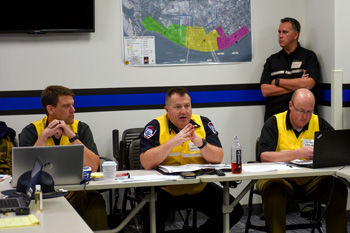About Emergency Services Planning
Emergency services planning is responsible for all state planning development and maintenance services related to the following emergency management areas:
- State Emergency Operations Plan (EOP)
- Indiana Mutual Aid Response Plan (IMARP)
- Complex Coordinated Terrorist Attack Response Plan (CCTA)
- Terrorism Response Plan
- State EOC Response Plan
- Crisis Communications Plan
- Disaster and Emergency Communications Plan
- Indiana Civil Unrest Plan
It also coordinates with the State Emergency Operations Center, law enforcement, facility personnel and agency stakeholders regarding the Indiana Government Center Active Shooter Response Plan. Additionally, the emergency services planner is the lead planner and coordinator for Emergency Support Function (ESF) annexes 1, 2, 4, 9, 13 and 15.
The emergency services planner is a trusted agent for the federally mandated Homeland Security Personal Identity Verification-Interoperable (PIV-I) card credentialing and issuance project. The planner also provides direct support services to the State Emergency Operations Center during activations, exercises and trainings. Management of these program plans directly contributes to the successful response, recovery and resilience of Indiana's communities after incidents and disasters.
This area of planning also collaborates on planning development initiatives with county, district, regional, state, federal, military and private partners and develops plan-specific templates to be used by county emergency managers for developing their protection, prevention, response and operational plans.
Highlights
Emergency services planning covers a wide scope of work. Below are just a few of the areas.
- State Emergency Operations Plan (EOP)
The State Emergency Operations Plan provides a statewide framework for the effective coordination of response operations in support of local governments before, during and after large-scale or complex emergencies and disasters. The Base Plan defines roles and responsibilities for state emergency management functions, establishes the conditions under which state resources are mobilized, and describes the organizational concepts and structures used to coordinate actions of state entities and other levels of government. The identification and organization of assigned roles among stakeholder entities are based on their unique resources and capabilities for emergency support efforts.
Furthermore, the plan utilizes the Emergency Support Function (ESF) concept to apply state resources and describes the responsibilities of state agencies in executing effective response and recovery operations. There are 15 emergency support functions identified within the plan, as well six Recovery Support Functions (RSFs). Each are defined in a separate annex. Additional annexes to the state plan include hazard-specific plans and other support-specific plans.
- Disaster and Emergency Communications Plan


The Disaster and Emergency Communications Plan provides an integrated state and local approach to ensuring effective communications coordination during a major incident affecting the state of Indiana. The plan also sets the foundation for how Indiana will work to create a temporary communication pathway while restoring the existing, permanent infrastructure when communication networks are disrupted, and how to appropriately alert the public in times of need. This plan and its appendices provide guidance to the state when primary communications pathways are overloaded or when a loss of communications infrastructure occurs due to an incident of significance affecting local, district, state or multi-state communications.
All incidents originate and are managed at the local level. As an incident escalates, the need for emergency communications across different disciplines, jurisdictions and levels of government also escalates. The ability of responders to communicate in real time is critical to establishing command and control of an incident, maintaining situational awareness and operating overall within a broad range of incidents. Ensuring that there is an accessible framework for communications coordination, including solutions to support local requests for communications assistance, is imperative.
- Complex Coordinated Terrorist Attack Regional Response Plan


The Complex Coordinated Terrorist Attack (CCTA) Regional Response Plan supports preparedness, response and recovery efforts for a complex and coordinated terrorist attack and is designed to guide responders through all terrorist incidents regardless of cause or complexity within the Indiana/Kentucky region. CCTAs are an evolving and dynamic terrorist threat, shifting from symbolic, highly planned attacks to attacks that could occur anywhere, at any time, with the potential for mass casualties as well as significant infrastructure damage and economic impact.
The CCTA plan was developed to assist all jurisdictions within the states of Indiana and Kentucky by providing a guide on how to respond to an attack. The plan is based on the premise that regional response assets are part of an integrated and resilient response system. CCTA incidents in general are incidents that exceed local capabilities and will require assistance from the region, state and/or federal agencies. This plan addresses local jurisdictions’ response, requests for assistance, coordination of resources and the processes necessary to assure the highest possible integration of regional, state and federal resources into the local response and eventual transition of responsibility to federal authorities.

